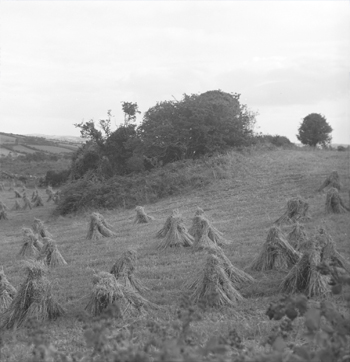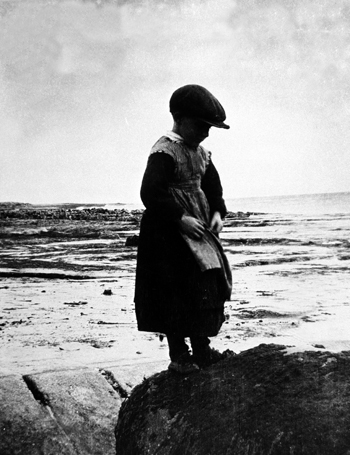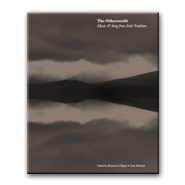Posted 28 January 2013
Fairies, both good and evil, in Irish traditional music and song
Belief in the fairy world or a sphere of existence parallel to that of the mortals was extremely strong in the Irish folk tradition. Fairies (and otherworldly beings) were both feared and respected.
The sí, as they are often known in Irish, are generally invisible to mortals. They are reputed to live in liosanna or raths or cairns, and are believed to become involved in human activity.

Corn stooks of four sheaves in a field with fairy rath or fort in the background, Loughinisland, County Down, 1962. (Photograph copyright National Folklore Collection, University College Dublin)
People generally believed it was unlucky to call fairies by their name and consequently appellations such as na daoine maithe [the good people], na daoine uaisle [the gentry] or bunadh na gcnoc [the people of the hills] were used.
“Arguably these beliefs are one of the ways people try to rationalise what appears to be inexplicable to them,” says Professor Ríonach uí Ógáin of the National Folklore Collection, University College Dublin.
A calamity at sea or an untimely death might be explained by a curse or fairy abduction. Even a curious natural phenomenon such as a whirlwind might be blamed on the slua sí [fairy host] passing.
“Belief in the existence of a parallel world and in otherworldly phenomenon has long been established in Irish tradition and facets of such belief continue to be found in contemporary society,” continues Professor uí Ógáin from the UCD School of Irish, Celtic Studies, Irish Folklore, and Linguistics.
There are tensions between mortals and the fairy world, between the living and the dead, the realms of good and evil.
“It is thought that young boys were sometimes dressed in skirts to protect them from fairy abduction because it was believed that the fairies would choose boys before girls.

Boy in petticoat, Inis Meáin, County Galway, 1930. It is thought that young boys were sometimes dressed In skirts to protect them from fairy abduction. A belief existed that the fairies would choose boys before girls. (Photograph copyright National Folklore Collection, University College Dublin)
In a new book, The Otherworld: Music and Song from Irish Tradition, UCD Professor Ríonach uí Ógáin and UCD graduate Tom Sherlock examine aspects of the enduring belief and fascination which the Irish imagination has with supernatural beings, encounters and occurrences as represented in traditional songs and music.
With two accompanying CDs of music, song and lore, the book explores the connection between the supernatural and excellence in the performance of music, benign supernatural encounters, and the existence of otherworldly creatures such as the banshee, the leprechaun or the púca.
The Otherworld: Music and Song from Irish Tradition contains just a tiny sample of the materials held in the National Folklore Collection at University College Dublin that deal with aspects of the Otherworld.
At the time of going to print, sixteen of the thirty-eight contributors featured in the sound recordings on the CDs were living. The earliest recording dates from the early 1920s while some of the material was recorded in recent years.
Funding for the publication was provided by Comhairle Bhéaloideas Éireann, The Arts Council of Ireland and The National University of Ireland.
(Produced by UCD University Relations)

